Image
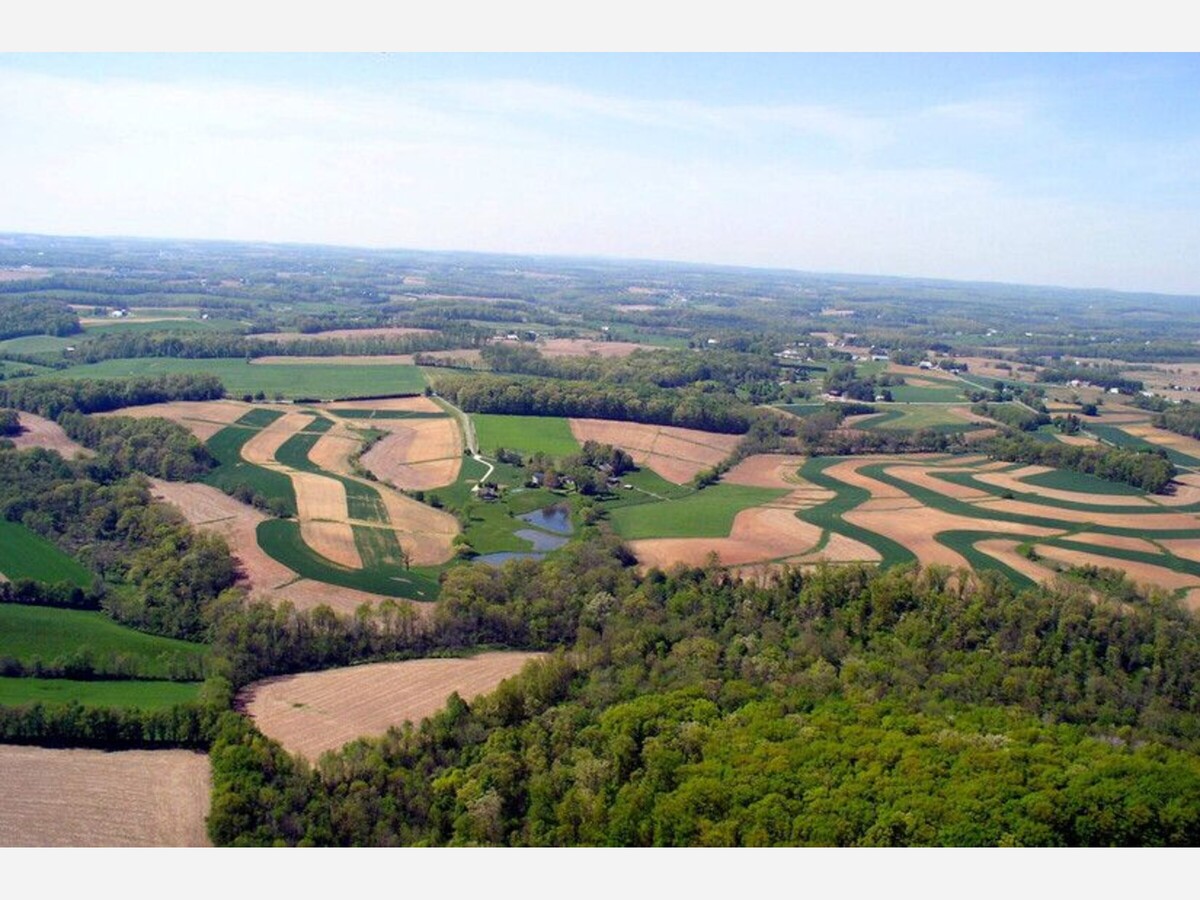

Cows at Rolling Stone Farm in St. Mary’s County. Photo by Rachael Pacella.
Whether it’s waterfront farmland , culturally important land where Harriet Tubman resided, a working farm in Baltimore County, or a stretch of quiet woodlands in Western Maryland, the Maryland Department of Natural Resources (DNR) Rural Legacy Program has been protecting it for a quarter century.
The Maryland Rural Legacy Program protects the viability of agriculture while also conserving natural resources and wildlife habitat within designated Rural Legacy Areas.
The Rural Legacy Program uses perpetual conservation easements to protect properties from development. Landowners are paid to relinquish certain development rights and effect restrictions on their properties ensuring that these working landscapes and habitats remain undeveloped in perpetuity. Farmers have reported that these payments have helped them expand and enhance their farming operations, while allowing them to protect the rural character of their communities for the future.
The easements are arranged by local sponsors, which include land trusts and county governments. These partners help to protect ecologically-important areas and working landscapes in the 36 designated Rural Legacy Areas that are spread across the state – there is at least one Rural Legacy Area in each of the state’s 23 counties. To date, the Rural Legacy Program has invested $405 million to preserve more than 125,000 acres of land in conservation easements since its inception.
The program recently celebrated its 25-year anniversary. To mark the occasion, DNR visited farms across the state and spoke with landowners about what the program means to them. Read their stories below.
St. Michael’s Ridge and King’s Ridge, Kent County
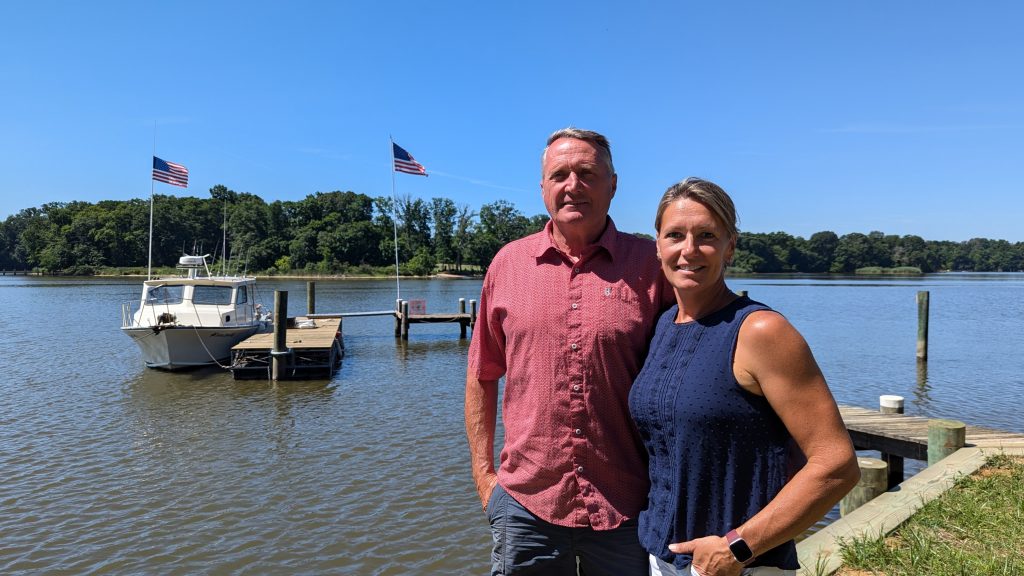
Albert and Kristen Nickerson pose on their property. Photo by Rachael Pacella.
Farm name: St. Michael’s Ridge and King’s Ridge
Farm owner: Kristen and Albert Nickerson
Location: Kent County, Agricultural Security Corridor – Harvest Crescent Rural Legacy Area
Total easement acreage: 988 acres under their ownership
Year (most recent easement): 2023
Rural Legacy Sponsor: The Eastern Shore Land Conservancy, Inc.
About the farm and farmers:
Kristen and Albert Nickerson purchased their first farm in Kent County 24 years ago. Albert’s family has lived on the Eastern Shore for six generations, and Kristen is a sixth generation farmer.
“I didn’t have any of this growing up. It was a dream,” Albert Nickerson said.
For more than two decades now the family has grown corn, soybeans, and wheat on the property, as well as alfalfa hay. They have expanded their operation over the years to adjacent properties. Their two sons have helped with the farm throughout their lives, and the couple hopes future generations take the same pride in the property and its agricultural history.
In 2023, the Nickersons were granted easements on 352 acres of property known as King’s Ridge, part of some 988 acres they have preserved as owners across their properties. The 677-acre farm they live on – St. Michael’s Ridge – was already protected by a conservation easement when they purchased it, bringing their total holdings of preserved property to 1,665 acres.
Their farm is home to a range of wildlife, including deer, turkey, eagles, and geese. Albert said it is extremely gratifying to be able to provide and protect wildlife habitat.
The property includes waterfront land along Jack’s Cove, which might have been developed if not for the Nickerson’s decision to conserve the land.

Photo by Rachael Pacella
“If it weren’t preserved, there would be houses all along the water,” Kristen said.
Albert Nickerson is a contractor, and his clients sometimes tell him they miss this or that convenience.
“They say ‘We love it here. You know what you need?’” Albert said. “And I say ‘yes I do: nothing.’”
The recent Rural Legacy easement will protect water quality in the watershed by limiting impervious surface to 2% of the property. The tilled agricultural land will be protected with a Soil Conservation and Water Quality Plan, and the forested acreage will be protected by a Forest Stewardship Plan.
This easement is part of a large block of conserved land – more than 900 acres in the area of Still Pond, north of Worton and south of Betterton.
The Eastern Shore Land Conservancy (ESLC) helped arrange the easement. Over the years, the ESLC has protected more than 13,000 acres through the Rural Legacy Program.
“Kent County being very resilient, being so focused in agriculture, not highly developed at this point, it’s a great place to invest resources,” ESLC Director of Land Conservation David Satterfield said.
Rolling Stone Farm, St. Mary’s County

Roberta and Jon Sola. Photo by Rachael Pacella
Farm name: Rolling Stone Farm
Owners: Roberta and Jon Sola
Location: St. Mary’s County, Mattapany Rural Legacy Area
Easement acreage: 80.97 acres
Year: 2022
Rural Legacy Sponsor: Southern Maryland Resource Conservation and Development Board
About the farm and farmers:
Roberta and Jon Sola took over a family-owned property and are now raising grass-fed cattle, while constantly striving to improve the soil on the land.
Roberta Sola’s great-grandfather moved his operation to the Rolling Stone Farm property in 1942. The family farmed until the 1980s, and then, for 40 years, the property was rented and cultivated by tenant farmers. Roberta’s brother, Robert “Moe” Stone, spent his time weeding, cutting grass, and manicuring the property, caring deeply to keep it as a farm.
When Robert Stone passed in 2018, Roberta inherited the farm. She and her husband, Jon, pursued land preservation to honor Robert’s wish that the property remain a farm in perpetuity.
“He was seeing other local farms turn into developments,” Roberta Sola said.
Now, Roberta and Jon are living out a dream – working full time and farming part-time while enhancing and protecting the land for their children.
The funds from the Rural Legacy conservation easement have allowed them to install regenerative practices on the farm. Since 2020, Jon has raised cattle.
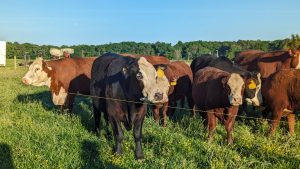
Photo by Rachael Pacella
The Solas eventually hope to grow and harvest hay for the cows to eat in the winter. Their cows rotate pastures, chewing grass and fertilizing the ground as they go. Their fields are full of earthworms, which produce some of the most nutrient-dense fertilizer available, Jon Sola said.
The improved soil absorbs more water, lessening runoff, so that the two stormwater ponds on the property are often dry.
The easement permanently protects forest on the property, as well as over 2,000 linear feet of riparian buffer along streams flowing into St. Mary’s River.
The Solas plan on adding chicken trucks to their operation. The truck, an enclosure on wheels with no bottom, will allow the Solas to move their chickens to a recently-grazed cattle field. The chickens scratch up the cow feces, spreading it around the field, and also eat fly larvae. The soil will continue improving, and there will be fewer flies pestering the cows.
The Solas have full-time work outside the farm, so they don’t have to always put profit first, but they may want to step-up the operation in the future, or their children may. They have purchased a commercially-zoned property near the farm, just in case they want to add a storefront to their farming operations one day.
Classes from St. Mary’s College have visited the farm for an eco-tour, and neighbors say they love seeing the cows.
“So there is a community impact,” Roberta Sola said.
The property was conserved through Southern Maryland Resource Conservation and Development Board, Inc. The group has worked with the Rural Legacy Program to conserve over 3,300 acres of land.
“We are delighted to see the Rolling Stone Farm evolve into a successful regenerative farm that is improving the local environment and engaging positively with the community,” Land Conservation Program Director Jessalyn Cockrell said. “Our mission is to help local families conserve their lands for generations to come, and we are excited to see what the Sola’s have planned for their farm in the future.”
Mid-View Farm, Frederick County
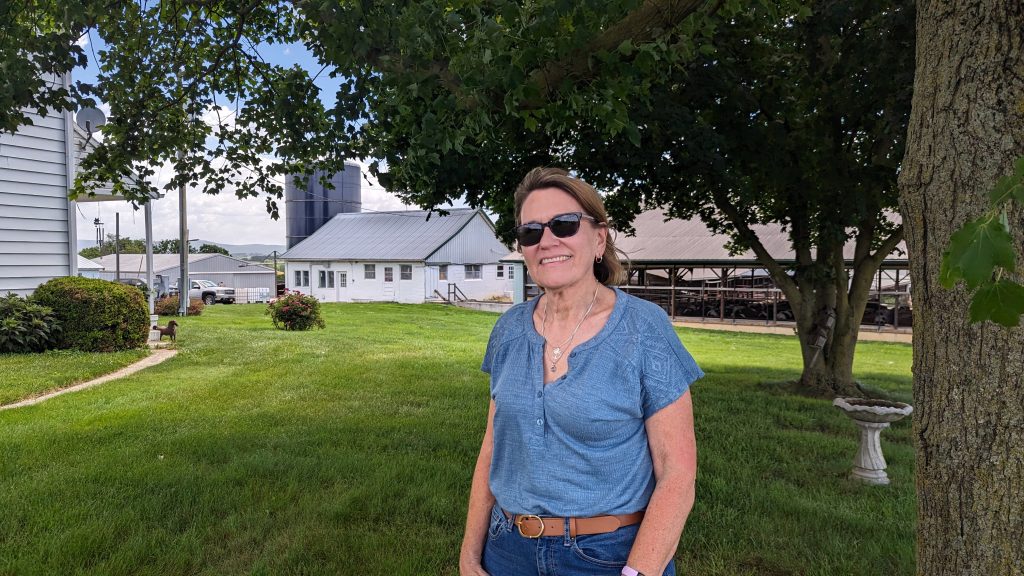
Sandy Tucker. Photo by Rachael Pacella
Farm name: Mid-View Farm
Owner: Sandy Tucker
Location: Within the Mid-Maryland Rural Legacy Area, Frederick County
Easement acreage: 165 acres
Year: 2015
Rural Legacy Sponsor: Frederick County Agricultural Preservation Program
About the farm and the farmers:
Sandy Tucker and her son, Justin Tucker, have protected their family’s land for future generations. In 2015, Sandy and her late husband, Stanley, conserved 165 acres through the Rural Legacy Program.
The family did what many participants in the program do – they spent their payment for the easement on securing and conserving even more farmland.
For the Tuckers, the easement money helped pay the mortgage on a 200-acre farm a short distance from Mid-View. Justin Tucker now owns that property, and has conserved it through the Maryland Agricultural Land Preservation Foundation. And so, conservation begets more conservation.
“We’re not going to grow houses,” Sandy Tucker said.
A dairy has operated on the Mid-View Farm property in Jefferson for more than 100 years.
When Sandy and Stanley Tucker operated the dairy, they were responsible for one of three daily milkings, the 2 a.m. shift. They would wake up around 1:30 a.m., set up the milking operation, start by 2 a.m. and milk until 7 a.m. One of the dairy’s employees was up even earlier wrangling cows into position.
Her husband’s family started the dairy in 1908, and Sandy married into the family farm and dairy in the late ‘70s. After Stanley’s passing in 2018, and given volatility in the dairy market, the family decided to sell the cows. The dairy barn was soon rented to a farmer who now raises dairy cows, steers, and heifers on the property.
Justin grows grain on the property, some of which is sold and used to feed those same cows.
The Mid-View property was protected through the Rural Legacy Program’s partnership with the Frederick County Government. Shannon O’Neil, the county’s Agricultural Preservation Program Administrator, said there is strong support for the farming community in Frederick County.
In the last 25 years, the county and DNR have preserved over 6,000 acres through the Rural Legacy Program.
On the 165-acre property put into easement in 2015, there is a forested stream buffer along 400 feet of Broad Run, which feeds into Little Catoctin Creek, then the Potomac River. The easement protects views from the Appalachian Trail, South Mountain State Park, and I-340.

Coltom Farm, Baltimore County

The Cole family. Photo by Rachael Pacella
Farm name: Coltom Farm
Owners: Family-owned, Tommy and Ashley Cole, Tom Cole Sr.
Location: Piney Run Rural Legacy Area, Baltimore County
Easement acreage: 42.8 acres (note, this easement is one of several completed by the Cole family)
Year: 2023
Rural Legacy Sponsor: The Land Preservation Trust
About the farm and farmers:
The Cole family has protected and owns 232.4 acres of farmland in Baltimore and Carroll counties, most recently placing 42.8 acres of land into a conservation easement inside the Piney Run Rural Legacy Area.
Tommy Cole’s grandfather first purchased that property in 1946. It was a dairy farm until 2008, when the cows were sold due to the declining profitability of dairy farming. His father grew up lending a hand at the dairy farm, as did he.
The cows are gone, but Tommy’s young son helps produce corn, soybeans, and hay. He loves riding in the tractor.
Their sweet corn is popular in the area – the self-serve stand sells out faster than they can fill it, Ashley Cole said.
His father, Tom Cole, works full time farming, and Tommy contributes part-time.
Putting some property into a Rural Legacy easement has given the family money to buy more farmland and expand their operation. When Tommy and Ashley married, they bought a farm and put it in conservation, using the payment from the easement helped to offset the cost of the land.
“We knew that putting land in preservation would be the only way we could purchase it and keep the community the same,” Tommy Cole said.
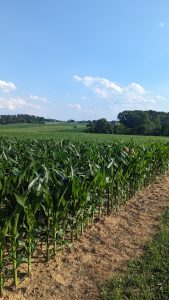
Photo by Rachael Pacella
The most recent conservation easement was completed through The Land Preservation Trust, an organization that has conserved 7,500 acres of land through the Rural Legacy Program. Ann Jones said there is a strong preservation ethic in the area.
“I don’t think there’s many places in the United States that are this close to major metropolitan areas that have this large a block of farming,” Ann Jones said.
The program has gained popularity through word-of-mouth.
“It’s neighbors talking to neighbors,” Jones said.
Once farmland has been developed, it’s gone, Jones said.
“You don’t see many houses being torn down to grow corn,” Tommy Cole said.